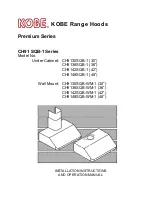
12
Direct Wire Installation: Copper or Aluminum Wire
This range may be connected directly to the fuse disconnect or
circuit breaker box. Depending on your electrical supply, make the
required 4-wire connection.
1.
Strip outer covering back 3" (7.6 cm) to expose wires. Strip
the insulation back 3/8" (1.0 cm) from the end of each wire.
B
A
A.
3/8" (1 cm)
B.
5" (12 cm)
2.
Allow enough slack in the wire to easily attach the wiring
terminal block.
3.
Complete installation following instructions for a 4-wire
electrical connection.
Electrical Connection Options
If your home has:
And you will be
connecting to:
Go to Section:
4-wire direct
B
A
A.
3/8" (1 cm)
B.
5" (12 cm)
A circuit breaker
box or fused
disconnect
4-Wire Connection:
Direct Wire
4-Wire Connection: Direct Wire
Use this method for:
�
New branch-circuit installations (1996 NEC)
�
Mobile homes
�
Recreational vehicles
�
In an area where local codes prohibit grounding through the
neutral
1.
Pull the wires through the strain relief on bottom of range.
Allow enough slack to easily attach wiring to the terminal
block.
A
B
D
E
F
G
c
A.
Terminal block
B.
Ground-wire
screw
C.
Cord/conduit
D.
Bare (green)
ground wire
E. Line 2 (red) wire
F. Nautral (white) wire
G. Line 1 (black) wire
2.
Attach terminal lugs to line 1 (black), neutral (white), and line 2
(red) wires. Loosen (do not remove) the setscrew on the front
of the terminal lug and insert exposed wire end through
bottom of terminal lugs. Securely tighten setscrew to torque as
shown in the following Bare Wire Torque Specifications chart.
A
B
C
D
E
A.
Terminal lug
B.
Setscrew
C.
Line 2 (red) wire
D. Natural (white) wire
E. Line 1 (black) wire
Bare Wire Torque Specifications
Attaching terminal lugs to the terminal block - 20 lbs-in
(2.3 N-m).
Wire Awg
Torque
8 gauge copper
25 lbs-in (2.8 N-m)
6 gauge aluminium
35 lbs-in (4.0 N-m)













































